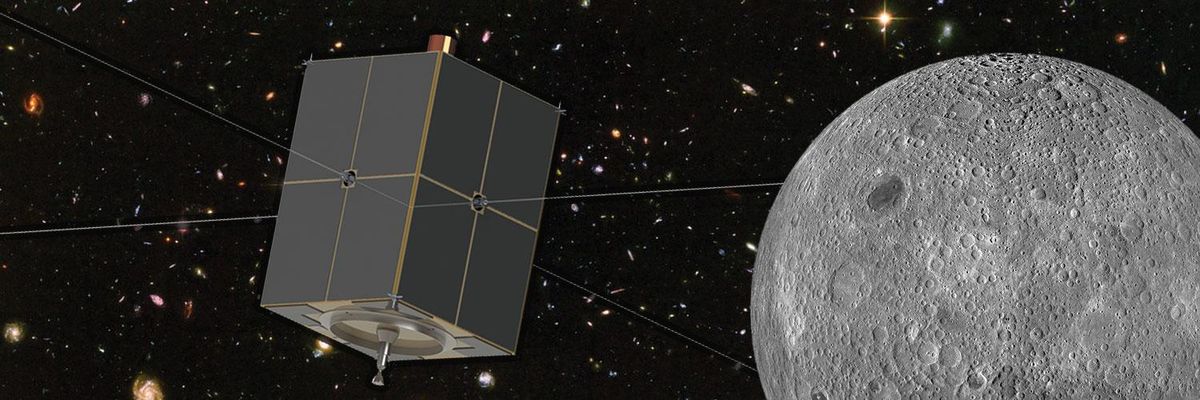
NASA's quest to return humans to the moon could boost a field of research that might not seem particularly lunar in nature: cosmology.
But the far side of the moon could be a powerful place to answer some of the most compelling questions about the universe — and NASA's push to bring humans back to the moon could cut the prices enough to make this science a reality. Even a scientist leading the push for NASA to investigate these missions admits it wasn't the most intuitive idea when he first heard about it.
"We were [science fair] judges together and they were asking me what I thought about telescopes on the moon," Jack Burns, an astrophysicist at the University of Colorado Boulder, told Space.com. "And I said, I didn't think much about it at all. It just didn't occur to me."
Related: Alien Hunters Need Radio Silence on the Moon. Future Lunar Missions Could Wreck It.
Since then, he and his colleagues have thought about it a lot. Their conclusion is that observatories on the far side of the moon offer a unique opportunity for modern astronomers. Burns has spent this year thinking through two specific mission concepts designed to take advantage, focusing particularly on the period before stars began to form, called the dark ages.
"It sounds ominous," Burns said of the epoch, but for scientists, it's mostly just intriguing. "It has a lot of potentially really interesting physics there and an opportunity to us to test the standard model of cosmology, and to see whether or not we can break it. You know, astronomers always want to break things."
These observations rely on being able to catch quite long radio waves, which are difficult to study from Earth because of interference from human technology on the planet's surface and in orbit. That's the appeal of the far side of the moon: It's the only place in our neighborhood protected from all of our chattering flashes of light.
"The lunar farside is such a rare environment," Burns said. "It's the only really quiet place in the entire inner solar system to conduct observations at very low radio frequencies, which, as it turns out today, is really the last unopened window to the electromagnetic spectrum."
So Burns and his colleagues have produced a report about each of two far-side radio-science concepts for NASA, which is looking for scientific research that could piggyback on the Artemis program, the agency's push to land humans on the moon by 2024. NASA Administrator Jim Bridenstine referenced one of the radio projects, an orbital mission, during a news conference about that campaign, dubbed the Artemis program, on Dec. 9.
"All of this science and all of this knowledge and all of this capability is going to be available to us because we are launching humans to the moon for the first time since 1972," he said. "We can get a whole lot more astrophysics science and information than we could ever get without having this architecture on the moon."
That architecture includes the Gateway, a NASA waystation for robots and humans bound for the lunar surface. The first module of the Gateway could launch in 2022, and the first mission he and his colleagues describe could fly the next year, Burns said, relying on communications developed for the waystation.
Related: Photo Shows Far Side of Moon Like Never Before
The science project, called Dark Ages Polarimetry Pathfinder, or DAPPER, is a spacecraft that would orbit the moon, spending about one-third of its time in the radio-quiet zone on the far side of the moon.
Burns and Bridenstine both said that building DAPPER in the context of the Artemis program would reduce mission costs. Burns said the project was designed with a $50 million price tag in mind; Bridenstine said that running the mission independently would cost about $500 million, but that being able to use Gateway's infrastructure would reduce that price to about $90 million.
The push to send radio astronomy equipment with the Artemis program doesn't draw its timeliness exclusively from convenience. It's also a matter of some urgency, since the rush to the moon by NASA, other nations and private companies could result in technology outshining these radio signals from the early universe, the same way it does on Earth.
"Part of the reason we want to do this sooner rather than later we want to get there first and observe while the environment is still pristine," Burns said.
DAPPER would be easier to execute than the other projects Burns and his colleagues have been considering, called the Farside Array for Radio Science Investigations of the Dark ages and Exoplanets (FARSIDE).
That project would hitch a ride on a commercial moon lander, like those NASA is hiring to carry its own scientific instruments to the lunar surface. Then, a rover would deploy 128 antennas across 6 miles (10 kilometers) of the far side to catch radio waves. Such a project could unfold in the mid- to late 2020s, Burns said, and cost about $1 billion.
In addition to doing cosmology research, such an array could also help astronomers understand which exoplanets might be most conducive to life. One key ingredient, scientists believe, might be a magnetic field that wraps around the planet and keeps an atmosphere in place.
"We maybe have come to the tentative conclusion that in order to form life like us, life as we know it, that having a magnetic field is very important," Burns said. And these magnetic fields should "light up" when viewed by radio telescopes, he said. "This is the only way to search for magnetic fields, with an array of these low frequency telescopes on the lunar far side."
Email Meghan Bartels at mbartels@space.com or follow her @meghanbartels. Follow us on Twitter @Spacedotcom and on Facebook.
Bagikan Berita Ini














0 Response to "Under a DAPPER Moon: NASA Eyes Wild Radio Science Projects on the Lunar Farside - Space.com"
Post a Comment